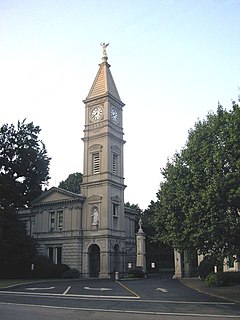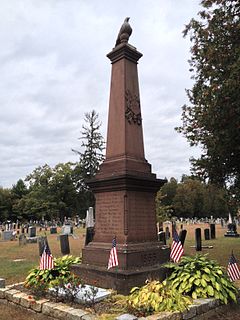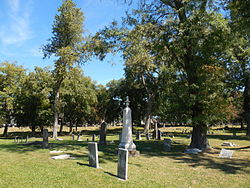
Cave Hill Cemetery is a 296-acre (1.20 km2) Victorian era National Cemetery and arboretum located at 701 Baxter Avenue, Louisville, Kentucky, United States. Its main entrance is on Baxter Avenue and there is a secondary one on Grinstead Drive. It is the largest cemetery by area and number of burials in Louisville.

The West Parish Burying Ground, also known as the River Street Burying Ground or River Street Cemetery, is a cemetery located at River and Cherry streets in West Newton, Massachusetts, and is listed on the National Register of Historic Places. Established in 1777, the cemetery is owned and maintained by the City of Newton; the Second Church in Newton, its original owner, was known as the West Parish.

Magnolia Cemetery is a historic city cemetery located in Mobile, Alabama. Filled with many elaborate Victorian-era monuments, it spans more than 100 acres (40 ha). It served as Mobile's primary, and almost exclusive, burial place during the 19th century. It is the final resting place for many of Mobile's 19th and early 20th century citizens. The cemetery is roughly bounded by Frye Street to the north, Gayle Street to the east, and Ann Street to the west. Virginia Street originally formed the southern border before the cemetery was expanded and now cuts east–west through the center of the cemetery. Magnolia contains more than 80,000 burials and remains an active, though very limited, burial site today.

The Pine Grove Cemetery, also known as the First Meetinghouse Burying Ground, is an historic cemetery on Tremaine and Main Streets in Leominster, Massachusetts. Established in 1742, it is the city's oldest cemetery, and the principal surviving element of the town's early settlement. It was originally located adjacent to the community's first meeting house, built in 1741 and dismantled in 1774. The cemetery, closed to burials since 1937, was listed on the National Register of Historic Places on March 12, 2008.

Wright Cemetery is a historic cemetery on Groton Road near Lynwood Lane in Westford, Massachusetts. The cemetery was formally established in 1836 as a private cemetery for the locally numerous Wright family, although its earliest documented burial dates to 1819. Maintenance and operation of the cemetery was taken over by the town in 1909. The half-acre plot has approximately 150 marked grave sites, and remains in use. The cemetery was added to the National Register of Historic Places in 2005.

Hillside Cemetery, also known as the North Burying Ground, is a historic cemetery on Depot and Nutting Roads in Westford, Massachusetts. The cemetery was established in 1753, and is the burial site of a number of people important in local history. It contains approximately 300 burials, and continues in active use. The cemetery was listed on the National Register of Historic Places in 2005.

The Mechanic Street Cemetery is a historic early cemetery on Mechanic Street in Westfield, Massachusetts. The 4-acre (1.6 ha) cemetery is the city's oldest, with the oldest documented grave dating to 1683. It was used as a burying ground until the late 19th century, although its use began to decline in the middle of the century, with the advent of the popular rural cemetery movement, which was reflected in Westfield with the establishment of the new Pine Hill Cemetery in 1842. No burials were recorded in the 20th century. Although the cemetery has been subjected to some maintenance work, it continues to suffer the effects of vandalism and weather. The cemetery was listed on the National Register of Historic Places in 2002.

The Main Street Cemetery is a historic cemetery on Main Street in Dalton, Massachusetts. Although the cemetery dates to 1781, much of it was laid out in the 19th century, during the rural cemetery movement. Its most prominent burials are those of the Crane family, whose papermaking business, Crane and Company, has dominated Dalton since the 1820s. The cemetery was listed on the National Register of Historic Places in 2000.
Cypress Cemetery is an historic cemetery at 100 College Street in Old Saybrook, Connecticut. Established sometime in the 17th century, and still in active use, it is the town's oldest cemetery, with a wide variety of funerary art dating from the 17th to 21st centuries. The cemetery's oldest portion was listed on the National Register of Historic Places in 2018.

Old North Cemetery is a historic cemetery on North State Street in Concord, New Hampshire. Established in 1730, it is the city's oldest cemetery. Franklin Pierce, fourteenth president of the United States, is buried in the cemetery, as are his wife Jane and two of his three sons. It was listed on the National Register of Historic Places on November 9, 2008. The cemetery continues to accept new burials.

The Downtown North Historic District is a 19-acre (7.7 ha) historic district in Hartford, Connecticut. It is a predominantly residential area located around Main Street and High Street north of I-84 and south of the Amtrak railroad tracks. Its apartment blocks, houses, schools and churches, built up mainly in the late 19th and early 20th centuries as part of an expansion of the city's urban core. It includes the 130-foot (40 m) Keney Tower. The area was listed on the National Register of Historic Places in 2004.

Mansfield Center Cemetery is a small cemetery in the Mansfield Center section of Mansfield, Connecticut. Established in 1693, it is one of the few surviving elements of Mansfield's early colonial settlement history. It also has a distinguished array of funerary markers carved by acknowledged masters across eastern Connecticut. It was listed on the National Register of Historic Places in 1992.

Center Cemetery is a historic cemetery in Southampton, Massachusetts. The 6.5-acre (2.6 ha) cemetery is located on the west side of Massachusetts Route 10, about 0.25 miles (0.40 km) north of Southampton Center. It was the town's first cemetery, with the oldest marker dating 1738. It remains its principal burying ground, providing resting places for the town's early settlers and later civic and business leaders. It was listed on the National Register of Historic Places in 2013.

The First Parish Burial Ground is a historic cemetery near 122 Centennial Avenue in Gloucester, Massachusetts. Established in 1644, the 2.5 acres (1.0 ha) site is Gloucester's oldest burying ground. It once stood at the heart of the Gloucester settlement, and was for 80 years its only cemetery. It was listed on the National Register of Historic Places in 1975. It is not well maintained.

The Old Westfield Cemetery is located at 320 North Street in the Danielson borough of Killingly, Connecticut. The cemetery was established in 1720, not long after Killingly's incorporation (1708). It occupies a 10-acre (4.0 ha) parcel on the north side of North Street, and is bounded in part by the Five Mile River. Its main entry is marked by granite pillars placed in 1920, giving access to a perimeter road. The cemetery is laid out in a form typical of 18th-century and early 19th-century, with graves lined up in relatively even rows, avoiding the mid-19th century rural cemetery movement. Most of its 450 graves date to the 19th century. The cemetery was listed on the National Register of Historic Places in 2010.

The Old Center Burying Yard or Center Cemetery is a historic cemetery at 30 N. Main Street in West Hartford, Connecticut. Established in 1719, it was the town's first cemetery, and its only burying ground for about seventy years. Many of West Hartford's prominent early settlers are buried here, including Noah Webster Sr. and his wife Mercy. The oldest portion of the cemetery remained in regular use until 1868, with the last documented burial in its newer section in 1971. It was listed on the National Register of Historic Places in 2002.

The Calvin Day House is a historic house at 105 Spring Street in Hartford, Connecticut. Built in 1852, it is the last survivor of a series of fine Italianate houses that lined a bluff overlooking Hartford's Union Station. It was listed on the National Register of Historic Places in 1978. It now houses a social service agency.

The Isham-Terry House is a historic house museum at 211 High Street in Hartford, Connecticut. Built about 1854, it was from 1896 home to members of the Isham family, who restored it in the early 20th century. The family donated the property to Connecticut Landmarks in the 1970s, which now operates it has a museum, offering guided tours and facility event rentals. The house was listed on the National Register of Historic Places in 1982.

Spring Grove Cemetery is a cemetery on Main Street in the Clay-Arsenal neighborhood of Hartford, Connecticut. Established in 1845, it is one of the city's oldest cemeteries, and its first private non-sectarian cemetery. Its burials include a number of the city's high-profile civic and business leaders, as well as a substantial indigent population, and artist Frederic Edwin Church. It was listed on the National Register of Historic Places in 2011.




























